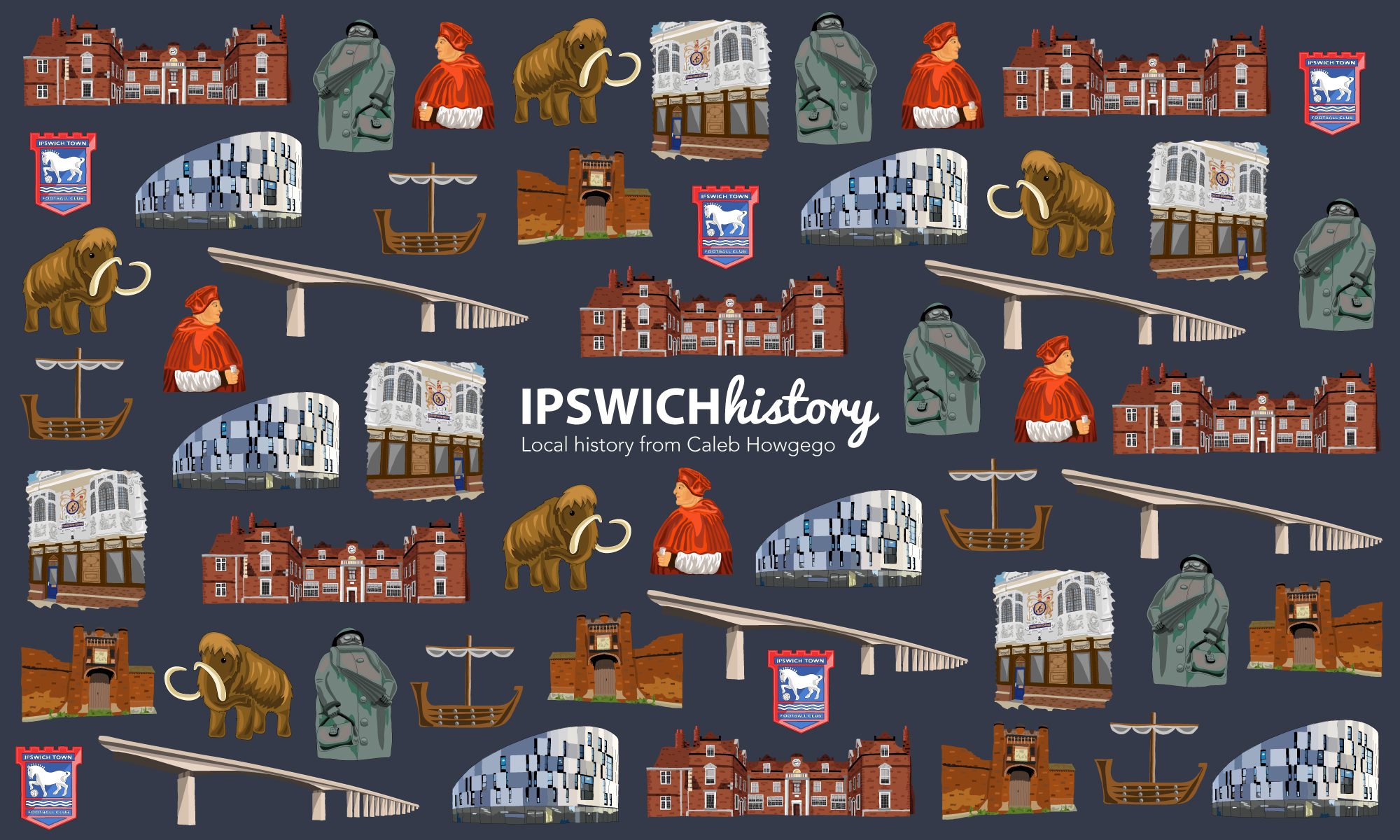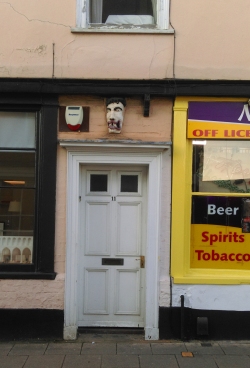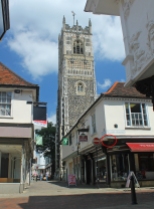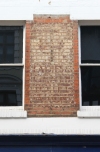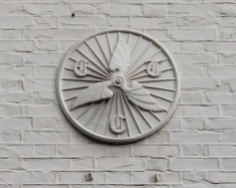I was recently invited on to Ipswich Community Radio for a chat about local history on the mental health discussion programme ‘Clearwater’. Here are some edited clips from the interview.
(THINGS ARE) LOOKING UP
It’s very easy to miss things that have been right under your nose for some time – I had cause to consider this point on more than one occasion over the Christmas season when, after eating a mince pie or two, I would catch a glimpse of myself in a mirror to find a dusting of icing sugar on my beard.
In that spirit, it occurred to me it would be interesting to uncover some of the historic and interesting things we walk past in Ipswich regularly but that go unnoticed – usually because it involves raising our gaze above shopfronts or because they are slightly hidden away. So, here follows some things worth looking up for:
Note: some of these finds I have come across myself over the past few years, but much additional information comes from Borin Van Loon’s Ipswich Historic Lettering website, which is an encyclopaedic record of historic signs and lettering in the town that continues to be regularly updated. If you would like to explore this topic further on his website please click here
Please click on images to enlarge them.
A Tudor Doorway and Beam
Hanging upon the brick wall facing the back of St. Stephen’s Church (now the Tourist Information Centre) is the last known wooden beam from the Tudor house of Thomas Rush, which once stood not far away in Brook Street. Rush represented Ipswich in the parliaments of 1523 and 1529 and was appointed Attorney in the building of Cardinal Wolsey’s ill-fated Ipswich College. Click here for more information on Wolsey’s College. The beam itself, which I must have walked past routinely for years without noticing, is intricately carved with mythical beasts, as well as with Rush’s merchant’s mark and his initial ‘R’.
Nearby on the south side of the church one of the buttresses, on closer inspection, actually contains a blocked up doorway. It seems Rush paid for a chapel to be built on the south side of the nave dedicated to him, for which this side door was the entrance. All that remains showing his connection to the former doorway now is his initial ‘T’ on one side of the buttress (presumably the ‘R’ on the other side has worn away over time).
Faces Under the Eaves
Have you ever walked along Eagle Street and noticed this strange plaster face staring down at you? Me neither, until I read about it in Susan Gardiner’s book Secret Ipswich and went to have a look for myself. Gardiner explains that it is very hard to say how old the face is but that it probably dates to the 1800s and that the face “has led to all kinds of strange tales, including a story about the house having been lived in by an ogre.”
On a similar note, I came across this strange face under the eaves of the Edinburgh Woollen Mill On the Buttermarket a couple of years ago, but haven’t managed to find any more information about it since then.
Ghostsign at Pickwicks
On the side of Pickwicks Coffee and Tea House in Dial Lane you can see an interesting example of a ‘ghostsign’ (an old shop sign painted onto brickwork that remains even though the building it is painted on has been re-purposed). This sign was hidden under newer layers of paint but was rediscovered in 2013 by a decorator working on the outside of the building. The sign, which is painted in a style that creates an optical illusion making it appear to be chiselled into the wall, reads “Spectacle Specialist Optician By Appointment to East Suffolk and Ipswich Hospital” You can read more about this discovery in a BBC news article here
It’s also worth noting the unusual iron gates by the entrance to Pickwicks as they clearly point to the building’s past as an opticians, depicting as they do, a pair of spectacles.
Lettering above Carphone Warehouse
Some more ghostsigns are to be found above the frontage of Car Phone Warehouse on Tavern Street, which appears to have been a hairdressers that expanded into an emporium of sorts run by the Wootton family. The remaining painted signs above the current shop facade list the services and wares once on sale at Wottons including: “LEATHER GOODS, STATIONERY, TOYS & GAMES, FANCY CHINA, HOT BATHS, FANCY COMBS, ‘PERMANENT WAVING’ and FACE MASSAGE.” To see a full transcribed list of all the text, visit Borin Van Loon’s excellent Ipswich Historic Lettering website here
Cyclists’ Touring Club
Here’s an unusual looking sign that features upon a wall on Upper Brook Street above a charity shop. This symbol comprising of three wings within a wheel and the initials ‘C T C’ is actually that of the Cyclists’ Touring Club, a forerunner of the modern-day Cycling UK. This sign was a seal of approval that these premises, once the Coach and Horses Inn, provided good accommodation and service to cyclists. According to the Ipswich Historic Lettering website it is thought that it was placed on this building “in about 1887”. To find out more click here
Police at the Town Hall
Above this side entrance to the town hall on Corn Hill the words ‘POLICE STATION’ can just be made out above the Roman numerals MDCCCLXVII (1867), being the year the current town hall was constructed. The town hall went on to host a police station for just over a century until 1968.
Although fairly innocuous, this doorway actually appeared in a cartoon drawn by the well-known cartoonist Carl Giles, which can be viewed on Borin Van Loon’s Ipswich Historic Lettering website here
Symonds for Kodaks
This sign, which probably dates to the early 1900s, was an advertisement for J.A. Symonds’ chemist’s shop that once occupied this building on Upper Brook Street. The American George Eastman introduced film rolls in 1883, this soon paved the way for his Kodak camera which brought photography to the wider public instead of just the privileged few who had previously owned plate cameras. Symonds was obviously a seller of this new equipment in Ipswich. I’m not quite sure how successful the sign itself was in advertising this, as I must admit I hadn’t really noticed it in over quarter of a century living in Ipswich until a few months ago, but then, maybe that says more about me than the sign.

WOLSEY’S GATE
When you walk through Westminster and admire the impressive white stone that comprises the Palace of Whitehall, there’s a good chance part of what you’re looking at was supposed to be a Tudor college in Ipswich.
Cardinal Wolsey was a powerful man in the 1520s – in fact, to be perfectly honest, he was probably the most influential man in England, aside from the king. Henry VIII had delegated much of state business to Wolsey, to the point where he administered both home and foreign affairs. This was all rather incredible considering Wolsey’s origins which, while not being destitute, were still relatively humble.
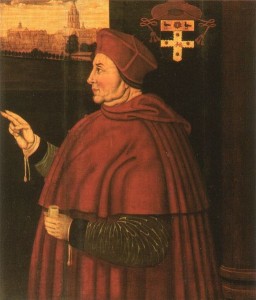
Born the son of a successful business man in Ipswich, Thomas Wolsey very probably studied at a local grammar school, before he enrolled at Magdalen College, Oxford. Wolsey’s glittering career began when he was ordained in 1498 and then became a parish priest in Somerset. Following this initial post he became Chaplain to the Archbishop of Canterbury, then Chaplain to Henry VII, and eventually served as Lord Chancellor to Henry VIII.
To put Wolsey’s importance into some kind of context it’s worth noting that he was responsible for organising the ‘Field of the cloth of Gold’ in 1520. This was a meeting of the powers of Europe, seeking to prevent future wars between Christian countries, rather like some kind of 16th century version of a United Nations meeting.
Wolsey was definitely one for building; during his years of power he spent much of his wealth on the construction of impressive buildings such as York Palace in Whitehall and Hampton Court. He also established Cardinal College, Oxford (now Christ Church College). To this institution he wished to add some fifteen feeder colleges in diocese around England, the main one was to be in Ipswich, his hometown.

The college in Ipswich was to be built upon the site of the Priory of SS Peter and Paul and to this end the priory was duly dissolved; providing both space and funds toward the building of Wolsey’s proposed school. Building of the college began including the now cherished ‘Wolsey’s Gate’ that was only ever supposed to be a small entrance for people arriving by water (Malster, Robert, Ipswich an A to Z of Local History, Wharncliffe Books, 2005).
In the meantime, before the building work was finished, pupils had started their study at the institution. A letter from the master of the school attached to the college survives, expressing the thanks of the school and the people of Ipswich, including examples of some of the handwriting of the boys in attendance.
Things were not destined to stay so rosy for Wolsey; the rise of Anne Boleyn saw his downfall. Anne took serious offence when Cardinal Wolsey failed to secure a quick annulment of Henry’s first marriage to Catherine of Aragon. Anne persuaded the king that Wolsey was deliberately putting a halt on the process. As a result, Wolsey was stripped of his office and the impressive buildings he had erected.
The downfall of Wolsey spelled the end for his grand plans for the name of his Cardinal College in Oxford, and the building itself of his main feeder college in Ipswich.
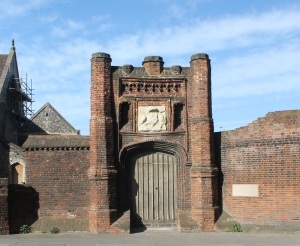
Now all that remains is Wolsey’s Gate; the last small fragment of Wolsey’s aspirations for his home town. In 1532, all the ‘timber, lead, wainscot and white stone of divers kind’ that remained in Ipswich, waiting to be used for the construction of the college, were packed up and taken by sea from Ipswich to the Galley Key by London Tower, ‘to be used for the king’s buildings at Westminster’ (Redstone, Lilian J., Ipswich Through the Ages, East Anglian Magazine Ltd, 1948). In a cruel turn of fortune, the very construction materials from Wolsey’s buildings in Ipswich were (now repossessed by Henry VIII) used to expand another of Wolsey’s projects in London – York Palace in Whitehall – that now belonged to the king.
As for Wolsey, he was granted a last minute reprieve from Henry and allowed to remain Archbishop of York. However, he was later accused of treason and summoned back to London to answer the charge. On the journey to the capital Wolsey fell ill at Leicester and subsequently died on 29th November, 1530.
An interesting footnote: Just as Wolsey had erected impressive buildings as residencies during his life, he had similar plans for his remains; he had planned a magnificent tomb in Windsor complete with a carved black sarcophagus. In the event of his unforeseen death in Leicester, he was buried in the Abbey of St. Mary of the Meadows. His grave is now unmarked and unknown. The black sarcophagus had to wait a further 275 years to be used. It now lies in the crypt of St. Paul’s Cathedral and contains the remains of another great Briton, Horatio Nelson.
